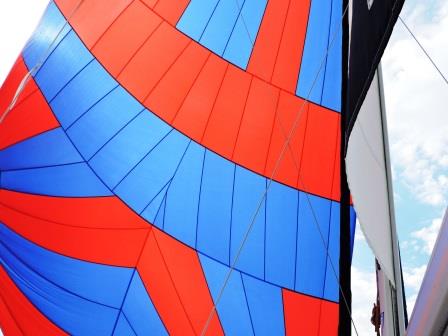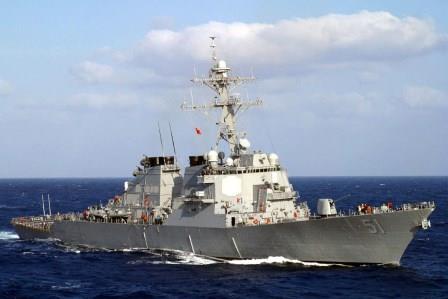
Question: What’s it like with a Navy captain sailing?
Answer: It shows the river from a different perspective.
Retired Capt. Terry Culton took his wife Helen and their son and his wife sailing on the York River on a quiet morning with almost no breeze. He’s familiar with these waters, having commanded many a Navy destroyer and cruiser on the 1:45 trip from the Norfolk Fleet to the Yorktown Naval Weapons Station for rearming.
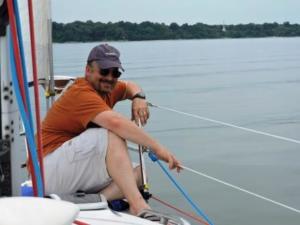 “The crew would ask why it took so long to get here, but they didn’t realize you have to dogleg to get up here in order to avoid the shoals. We would approach the bridge at 10 or 12 mph and slow to 8 mph at the bridge.”
“The crew would ask why it took so long to get here, but they didn’t realize you have to dogleg to get up here in order to avoid the shoals. We would approach the bridge at 10 or 12 mph and slow to 8 mph at the bridge.”
I asked if it was his choice to dock bow-in or bow-out. “It depends on what kind of work you’re doing to load or unload the boat. The dockmaster will consult with you on which side is best for the cranes to operate.”
Do you need the tugboats? “Yes, because the current in the river can run 3 or 4 knots. Even though the USS Arleigh Burke has 100,000 horsepower and twin screws, it’s still difficult to steer backward. This very bridge is used at the Navy training center in Newport, Rhode Island, to simulate swing spans. The first few times you try it on the simulator, they make it easy. Then they crank it up to 6 knots and you have to fight it.”
San Diego Traffic
Are civilian craft respectful? “Here they are, but San Diego harbor is tough. We’ll be coming in and face a regatta of 40 sailboats criss- crossing the channel, right off my bow. They think that as a sailboat they have the right of way. Come on! I’m a 12,000-ton warship with limited maneuverability. I can shift maybe 50 yards inside the channel. Sometimes they get within 100 yards of the boat, and then I’ll sound the ship’s horn. That scares the shit out of them.
“I came up as an engineer in the Navy, so I have great understanding and respect for my engineers. I give them a lot of latitude. I had an engineering casualty during the Iraq war where one of the two shafts wasn’t operating properly. We spent four weeks in Iraq that way, on the other prop, until we could get into dry dock. 17 degrees was the new center point on the boat.”
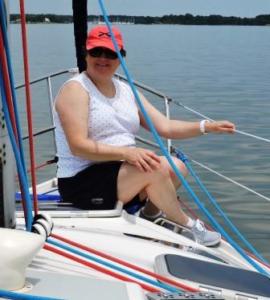 Helen is the coordinator of home health care for Sentara Norfolk General Hospital, with 650 beds. She found the quiet sail relaxing.
Helen is the coordinator of home health care for Sentara Norfolk General Hospital, with 650 beds. She found the quiet sail relaxing.
Yachts Sail Past
“We live in Great Bridge, near the Inland Coastal Waterway. We walk to town and see some magnificent boats coming and going. When I was a home health care nurse, I had to take care of a man who was delivering a yacht up the Inland Coastal. He suffered a severe laceration on the delivery trip and had to be treated for infection. He couldn’t leave the boat to go to the hospital, but he needed treatment and therapy. I’d go there in the evenings and dress the wound. We’d chat in the living room. It was like a party.”
For 11 of the past 13 years, the family has vacationed at Smith Mountain Lake, near Roanoke. They might retire there when she leaves Sentara and he leaves his retirement job as a training executive for the Navy Chief of Staff.
Ironically, Terry would have a hard time getting credentialed for my job, which among other things requires validating 100 days on the water for the previous three years. “The Coast Guard doesn’t recognize my sea time as a determining factor. Even now, when I go to rent a boat at Smith Mountain Lake, they make me fill out an experience form. ‘Hey, I’ve been coming here for years. I’ve run 9,000-ton destroyers.’” My own hunch is that the Coast Guard doesn’t want to get deluged with retired Navy captains seeking commercial licenses.
As we headed in, Terry marveled, “In all the years I’ve come up the York River, I’ve never seen it this calm.” Me too.
Anniversary Sail
Later a couple drove in from Fort Lee to celebrate their 17 anniversary. Katrina Stevenson served four years in the US Army and now works at the Richmond VA Hospital. Torin Stevenson has 21 years in and teaches machine repair. We chatted about my 18 HOhp Yanmar, which he looked at respectfully.
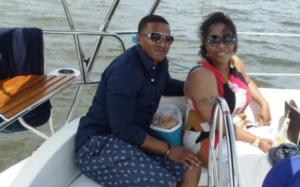 He’s technically with the 82nd Airborne at Fort Bragg, North Carolina. The distinction between the 82nd and 101st is that the former is air assault while the latter is ground assault.
He’s technically with the 82nd Airborne at Fort Bragg, North Carolina. The distinction between the 82nd and 101st is that the former is air assault while the latter is ground assault.
“We don’t use parachutes,” he clarified. “We rappel from helicopters. During the final test, you have to slide down halfway and stop. Then you resume. We have a D ring to work the ropes. They’re tied around your thighs and are very uncomfortable. I missed a point once and got turned upside down with a 2×4 board under my shoulder. All my weight was on my armpit and eventually my shoulder got pulled from the socket. After I recovered I was allowed to finish the course.”
The wind picked up from the east, and Torin tacked four or five times downriver. Near the Yorktown oil terminal, we turned around and put up the spinnaker to come back straight downwind. He recognized the spinnaker as a glorified parachute and instantly got the feel for it. Katrina held the spin sheet to get the feel for the back-and-forth. Their experience on land enabled them to quickly get the grasp of sailing. My only regret was that Capt. Culton didn’t get the same chance.
Let’s Go Sail
Check rates and pick a day for a sailboat charter. See reviews on Trip Advisor from sailors like you.
